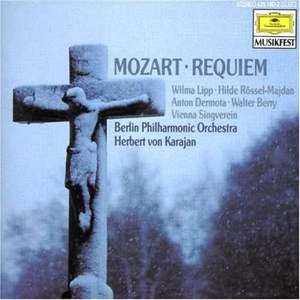Born in Salzburg, then in the Holy Roman Empire and currently in Austria, Mozart showed prodigious ability from his earliest childhood. Already competent on keyboard and violin, he composed from the age of five and performed before European royalty. His father took him on a grand tour of Europe and then three trips to Italy. At 17, he was a musician at the Salzburg court but grew restless and traveled in search of a better position.
While visiting Vienna in 1781, Mozart was dismissed from his Salzburg position. He stayed in Vienna, where he achieved fame but little financial security. During his final years there, he composed many of his best-known symphonies, concertos, and operas. His Requiem was largely unfinished by the time of his death at the age of 35, the circumstances of which are uncertain and much mythologized.
Kyrie
Wolfgang Amadeus Mozart Lyrics
Jump to: Overall Meaning ↴ Line by Line Meaning ↴
Christe eleison.
Kyrie eleison.
The Kyrie is a part of the Catholic Mass that originated from the Greek Orthodox Church. Mozart's Kyrie is a setting of the Kyrie text, which is a prayer that means "Lord have mercy, Christ have mercy, Lord have mercy." Mozart's Kyrie in particular is classified as a choral piece, and it is sung a cappella, meaning without any instrumental accompaniment.
The piece begins with the phrase "Kyrie eleison" sung by the choir. This phrase is then repeated twice more with the next phrase, "Christe eleison" interrupting after the first repetition. The first phrase is Greek for "Lord have mercy," and the second phrase is a plea to Christ for mercy. After the interruption of the "Christe eleison" phrase, the choir repeats the "Kyrie eleison" phrase for the third and final time.
While the piece is simple in its structure, vocal harmonies, and melody, it is truly a masterpiece that showcases Mozart's skill and talent as a composer. The way in which he arranged the phrases and harmonies create an emotional and powerful experience for the listener. It is no surprise that this piece has remained a popular selection in choral music even centuries after it was first composed.
Line by Line Meaning
Kyrie eleison.
Lord, have mercy.
Christe eleison.
Christ, have mercy.
Kyrie eleison.
Lord, have mercy.
Contributed by Skyler K. Suggest a correction in the comments below.

@mabovithzelthz4580
キリエ【あわれみの賛歌】
第2曲 主よあわれみ給え
Kyrie eleison.
「主よ、いつくしみをお与えください」
Christe eleison.
「キリストよ、いつくしみをお与えください」
Kyrie eleison.
「主よ、いつくしみをお与えください」
「キリエ(主よ、いつくしみをお与えください)」
@johanliebert6270
The greatest genius in music...Requiem is the pinnacle of human art.
@lennierichardson1387
It's a ballbuster to sing, too. :D
@dinare8
Noooo... not you again!
@gotaro69
yo johan
Where did u escape
@nidz4
Johan Liebert you don’t exist!!!!!!
@katerinaroumelioti9475
πειράζει
@stratiotis1979
Masterpiece! Kyrie eleison. (God have mercy on us). Immortal Greek language.
@carlochang6592
It's latin
@stratiotis1979
@carlochang6592 No, my friend. This is Greek language written in Latin alphabet. Kyrie means "Lord" and Eleison means "Have mercy on Us."
@carlochang6592
@@stratiotis1979 ok no sabia saludos,,,,